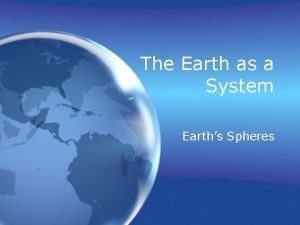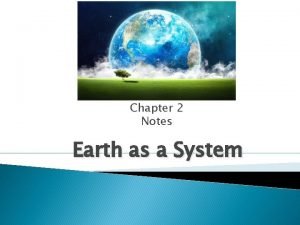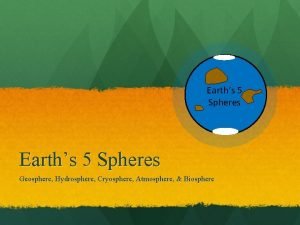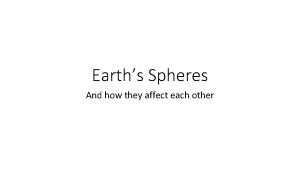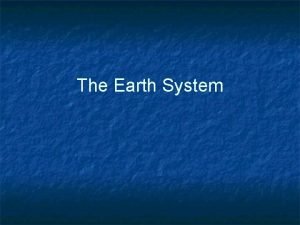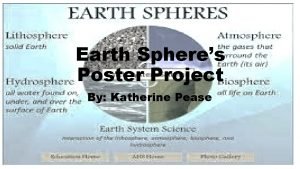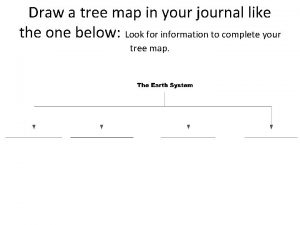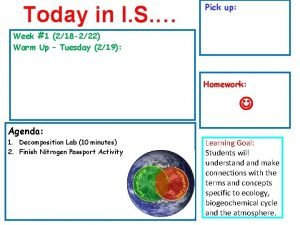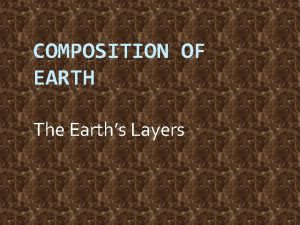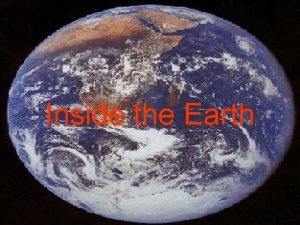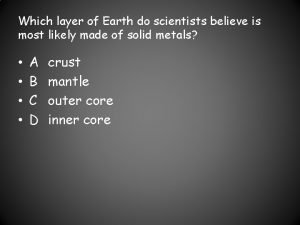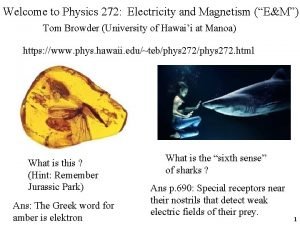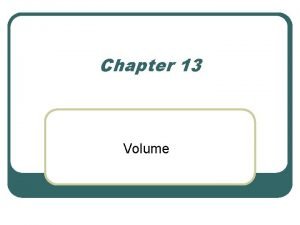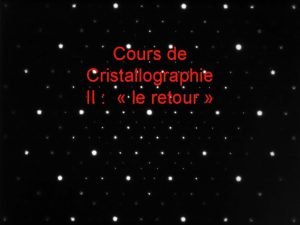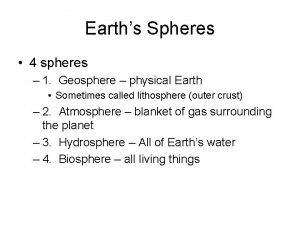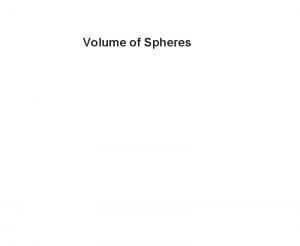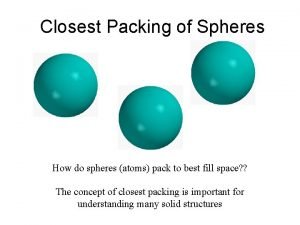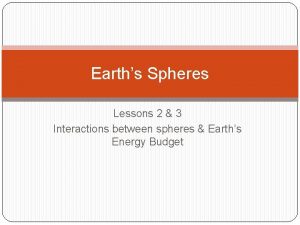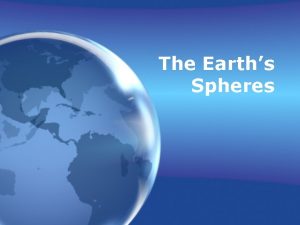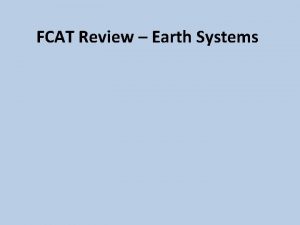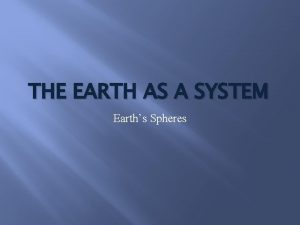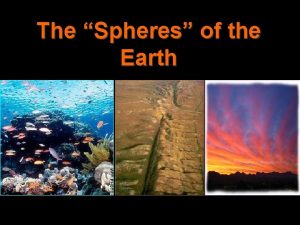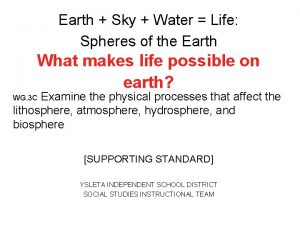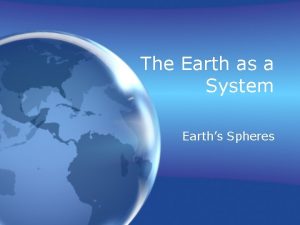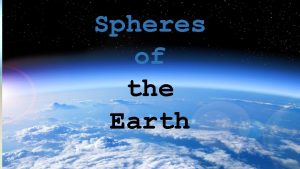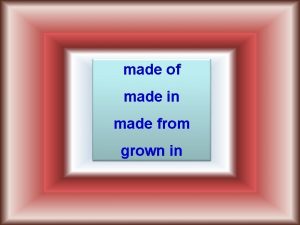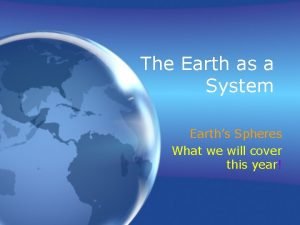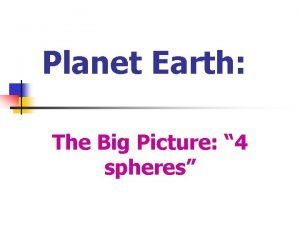Spheres of the Earth The earth is made





















- Slides: 21

Spheres of the Earth The earth is made up of four main spheres which allow us to live and function. These layers must exist in harmony and work together or our Earth would fall apart.

The Four Realms of Earth! • Atmosphere • Lithosphere • Hydrosphere • Biosphere

Atmosphere • Gaseous layer which surrounds the Earth • Receives heat and moisture from the surface and redistributes it • Warms the Earth • Without it all living things would die • Consists of a mixture of gases composed primarily of nitrogen, oxygen, carbon dioxide, and water vapor.

Lithosphere • • • Often called the Earth’s crust Outermost solid layer of Earth It’s what we’re all standing on Includes continental and oceanic crust Solid bedrock with a layer of soil It’s surface is filled with all sorts of landforms – habitats for animals, plants, humans, etc.

Hydrosphere • Liquid realm • All the Earth’s water: rain, ponds, lakes, rivers, oceans, ice cap, glaciers • Earth is made up of 70% water, which is why we’re sometimes called the “Water Planet”

Biosphere • First one hundred meters is referred to as the “life layer” • Includes all life an Earth: plants, animals and people • This sphere connects it all together

All four work together • Spheres of Earth

The Atmosphere, Lithosphere, Hydrosphere and Biosphere CONNECTION! • How is it all connected? – All four spheres are directly and indirectly connected – Any change the occurs on one sphere can and will affect the others – Changes often cause chain reactions – The connection takes place on the “Life Sphere” located on the Biosphere • For Example: Forest Fire, Earthquake, Pollution • Can be caused naturally or by people

Most famous Interaction: Water cycle Water Cycle = Hydrologic Cycle • Take a look at this glass of water and put it on the table next to you. Take a good long look at the water. Now -- can you guess how old it is? • • The water in your glass may have fallen from the sky as rain just last week, but the water itself has been around pretty much as long as the earth has! • When the first fish crawled out of the ocean onto the land, your glass of water was part of that ocean. When the Brontosaurus walked through lakes feeding on plants, your glass of water was part of those lakes. When kings and princesses, knights and squires took a drink from their wells, your glass of water was part of those wells. • And you thought your parents were OLD!

Parts of the Hydrologic Cycle • Evaporation (and transpiration) - Infiltration & Runoff • Condensation • Precipitation • Collection

Step 1: Evaporation • Evaporation: Evaporation is when the sun heats up water in rivers or lakes or the ocean and turns it into vapor or steam. The water vapor or steam leaves the river, lake or ocean and goes up into the atmosphere.

And plants? • Do plants sweat? • Well, sort of. . people perspire (sweat) and plants transpire. Transpiration is the process by which plants lose water out of their leaves. Transpiration gives evaporation a bit of a hand in getting the water vapor back up into the air.

Runoff & Infiltration • These two happen at the same time (simultaneously) with Evaporation, because some of the water evaporates too • Infiltration is when precipitation is absorbed into the ground • Runoff happens when too much precipitation falls too quickly and it “runs” over the ground • In both cases the sun can warm it and it can evaporate to take part of the Hydrologic Cycle

Step 2: Condensation • Water vapor in the air gets cold and changes back into liquid, forming clouds. This is called condensation. • You can see the same sort of thing at home. . . pour a glass of cold water on a hot day and watch what happens. Water forms on the outside of the glass. That water didn't somehow leak through the glass! It actually came from the air. Water vapor in the warm air, turns back into liquid when it touches the cold glass

Step 3: Precipitation • Precipitation occurs when so much water has condensed that the air cannot hold it anymore. The clouds get heavy and water falls back to the earth in the form of rain, hail, sleet or snow.

Step 4: Collection • When water falls back to earth as precipitation, it may fall back in the oceans, lakes or rivers or it may end up on land. When it ends up on land, it will either soak into the earth and become part of the “ground water” that plants and animals use to drink or it may run over the soil and collect in the oceans, lakes or rivers where the cycle starts • all over again.

Hydrologic Cycle #1

Hydrologic Cycle #2

Hydrologic Cycle #3

Hydrologic Cycle in Action • Water Cycle - Simplified

Demonstration Our indoor Water Cycle!
 Sphere of earth
Sphere of earth Geosphere examples
Geosphere examples Earth systems foldable
Earth systems foldable What is biosphere and geosphere
What is biosphere and geosphere Living soil vs dead soil
Living soil vs dead soil 4 spheres of the earth
4 spheres of the earth Earth's spheres foldable
Earth's spheres foldable Earth's spheres
Earth's spheres How can you compare the terrarium to an earth system?
How can you compare the terrarium to an earth system? The four spheres
The four spheres Earth sphere poster
Earth sphere poster Hydrosphere drawing
Hydrosphere drawing Four spheres of the earth
Four spheres of the earth What is the earth's atmosphere made of
What is the earth's atmosphere made of The 4 layers of the earth
The 4 layers of the earth What is the center of the earth made of
What is the center of the earth made of Which layer of earth is most likely made of solid metals
Which layer of earth is most likely made of solid metals Cone volume ratio
Cone volume ratio Surface area and volume maze
Surface area and volume maze You have two lightweight metal spheres each hanging
You have two lightweight metal spheres each hanging 13-1 volume of cylinders
13-1 volume of cylinders Volume maille monoclinique
Volume maille monoclinique
